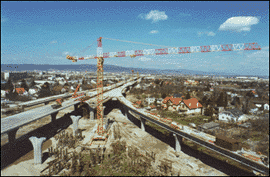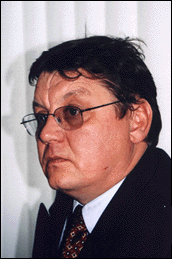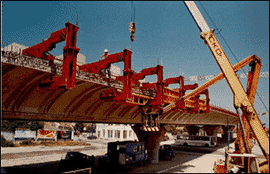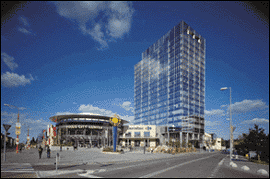
|

 Introduction - Banking - Industry - Food & Beverage - Transport Introduction - Banking - Industry - Food & Beverage - Transport
Construction - Utilities - Telecommunications
 CONSTRUCTION CONSTRUCTION |
 Expanding, but investment needed Expanding, but investment needed |
Over the past ten years, the competitiveness and quality of service within the Slovak construction sector has shown remarkable advancement and development. Slovak construction companies have now reached European standards and the structure of the industry is now similar to Western countries. However, the development over the past decade was not so favorable, as the sector is still suffering from the effects of social transition and a significant lack of foreign investment

After the Velvet Revolution, most industries and industrial areas in Slovakia collapsed. The problem occurred due to insufficient diversification of the industry and the economy, a relic of the centrally planned economic era. Most of the larger industrial companies were operating in a non-competitive environment, and therefore had to learn how to survive in the changing market-economy.
It has been said that the construction sector is the best indicator regarding the industrial development of a country.

In Slovakia, in 2000, the total output for the construction sector was equivalent to just one third of the total output in 1989. In 2000, the share of the construction production within the Slovak GDP was 4%, and the construction sector employed approximately 7% of the total active population.
Out of the 41,000 Slovak construction organizations, the larger and middle-sized companies accounted for only 2%, but they employed about 50 % of all employees in the construction sector.
After 1995, the Slovak construction sector lost nearly one-third of its 88,000 workforce. "There are two reasons to explain this," thinks Mr. Ivan Sestak, CEO of Doprastav Construction Company: "One is the recession in industrial and residential building, the other is rather positive: using new advanced technology methods of running the business increases the productivity but requires fewer people." Along with the rest of the Slovak economy, the construction sector suffered from a crippling recession until the end of 1998. Since its recovery in 1999, the country has experienced a continual annual growth.
Construction sector statistics, in billions of SKK
1996 1997 1998 1999 2000
Output 62.0 74.1 77.6 64.0 69.5
Real annual growth, % 4.4 9.2 -3.7 -25.8 -0.4
Share of GDP, % 7.15 6.95 6.42 5.20 4.77
Profit N/a 3.2 1.2 0.7 1.2
Foreign investment 1.0 1.4 1.6 1.8 1.7
Employees, thousands of 88.7 84.5 83.0 69.9 59.1
Source: Slovak Statistics Office.

At present the competitiveness level of the Slovak construction market is similar to EU countries. "The construction market was the first sector to be privatised," says Mr. Slavik, President of the Chamber of Construction in Slovakia.
However, the export of construction services has showed a significant decline, as there is reduced demand from the former Soviet Union that previously sought contracts from Slovak construction firms.Growth in the sector is pulled by domestic construction particularly with regards to expanding retail outlets together with housing and apartment construction, while in order for factory construction to improve a radical increase in foreign direct investments is needed.

"We need investments as much as live-giving
blood," says Frantisek
Hirner, General Manager of ZIPP , the most successful
Slovak construction company on foreign markets.
|

In the past, Slovakia did not allow foreign investment to enter the country and chose instead to establish a domestic-owned capital environment. "There is a great potential but there are no funds, the reason for this lies in the past, in the 90's, the era of privatization," says Mr.Oto Hornacek, Chairman and Director General of Hornex.

In comparison with the Czech construction sector, the current Slovak construction industry is in deficit. Mr. Istvan Harna, Minister of Construction and Regional Development agrees: "Slovakia definitely needs more foreign investment than what it now has, more foreign capital is needed to restructure the whole construction sector."
The government is helping the sector by placing emphasis on public demand for improved transport infrastructure construction. The government has also set out ambitious plans for residential and apartment construction projects.

The Ministry of Construction and Regional Development is responsible for creating and implementing the government's policy in areas such as construction, regional development, state housing policies, construction products, and public works. According to the accession negotiations with the EU, the Minister is responsible for Chapter 21, related to regional development and structural funds. Full application of all chapters is set for January 2004, which was also set as the first possible date for the Slovak Republic to become an official EU member.
At present, Slovakia is participating in three pre-accession programs of the European Union - ISPA, SAPARD and PHARE.
The largest construction companies are the ones experiencing the most significant annual growth. Most of the top ten Slovak construction firms are former state-owned companies privatized through direct sale to Slovak entrepreneurs. The larger companies specialize in the construction of special facilities - such as Doprastav in motorways, roads, bridges, and infrastructure systems. Vahostav is specialized in water facilities along Slovakia's longest river Vah, and Hydrostav specializes in the construction of waterworks and dams. Liquidity problems and lack of industrial construction opportunities are their main problem. "Slovakia's big problem is its insufficient diversification of industry and economy, a relic of the central-planning economy era," Mr. Harna believes. Yet, successful investors like Volkswagen prove that cooperation between foreign capital and domestic construction companies can lead to both mutual satisfaction and growth.
"Strong foreign building corporations are already entering our market, and have no difficulties in fulfilling guarantees and other conditions imposed by financial institutions and banks," stated Mr. Hirner, General Manager of ZIPP Construction.

ZIPP is probably the best example of Slovak competitiveness
as it has a strong position in the surrounding markets.
In the past, ZIPP was able to expand to Western
European markets, and after gaining enough experience
the company returned to Slovakia and became the
fastest growing construction company in the sector.
Typical contracts for ZIPP include business centers,
shopping malls, skyscrapers, production halls, and
factories. |
| Biggest construction companies in Slovakia | NetRevenues
(000 SKK) | Pre-taxprofit
(000 SKK) | Total assets2000
(000 SKK) | Total debt2000
(000 SKK) | Average number of employees
2000 | | 2000 | 1999 | 2000 | 1999 | | Hydrostav, a.s., Bratislava | 7 298 087 | 7 362 509 | -59 660 | -173 447 | 6 871 139 | 6 185 802 | 4 597 | | Doprastav, a.s., Bratislava | 4 479 831 | 2 630 205 | 102 727 | n/a | 2 947 342 | 1 139 054 | 2 762 | | ZIPP, s.r.o., Bratislava | 4 383 697 | 3 367 172 | 150 026 | 16 214 | 1 817 768 | 1 389 469 | 2 176 | | Vahostav, a.s., Žilina | 2 643 488 | 2 386 377 | 2 163 | n/a | 1 951 518 | 1 290 902 | 2 329 | | Inžinierske stavby, Kosice | 1 783 031 | 1 551 806 | 22 240 | -160 213 | 1 332 262 | 687 825 | 1 724 | | Sibamac, a.s., Bratislava | 1 151 826 | 1 019 479 | -9 571 | -40 355 | 557 105 | 281 621 | 790 | | Cestne stavby, a.s., Kosice | 841 808 | 727 825 | -130 892 | -70 359 | 677 192 | 426 005 | 998 | | Cesty, a.s., Nitra | 755 119 | 549 386 | 17 946 | 4 618 | 475 722 | 89 769 | 732 | | Pozemne stavitelstvo, Nitra | 693 656 | 755 078 | -8 288 | -36 952 | 736 247 | 328 807 | 966 | | Hornex, a.s., Bratislava | 572 793 | 168 075 | 48 041 | 17 518 | 257 583 | 163 633 | n/a |
|
|
© World INvestment NEws, 2002.
This is the electronic edition of the special country report on Slovakia published in Forbes Global .
May 27th, 2002 Issue.
Developed by AgenciaE.Tv |
|
| | | | |
| |
|

